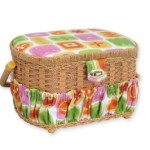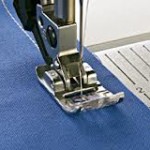
I’ve started a list of sewing essentials for your sewing machine and sewing room. The first list are must haves, whether you use a sewing machine or when sewing by hand.
The second list are optional items that are for decorative purposes or will help make some steps easier or more convenient.
Third, I list sewing supplies to be used with a sewing machine. Of course, the sewing machine itself is essential. Go to the home page for my recommendations on sewing machines.
Lastly, I’ve listed items that you will buy as you go, usually according to a project or pattern that calls for specific materials and notions.
Must Haves:
- Safety Pins – These are good for feeding elastic, lace or cording through a narrow or tubular piece. They are also good to use when quilting, and to hold several layers in place.
- Straight pins – I prefer ball head pins that are easy to grasp.
- Pin cushion or magnetic pin holder – Provides a safe place to keep your pins.
- Measuring tape – Get a soft cloth or vinyl tape measure for measuring fabric, waistlines, inseams, etc. I keep one of these in my purse. I’m always having to measure something while I’m out shopping.
- Scissors/Shears – I use Fiskars, the ones with the bright orange handles, or Gingher, a little more expensive but you don’t want to use cheap scissors. A good pair of fabric shears can be pricey, but if taken care of they will last a lifetime. Make sure you use your fabric shears for cutting fabric only, and not paper. Cutting paper will dull the blades, so keep a pair of paper scissors handy to avoid using your good fabric shears. You will also need other scissors for trimming and cutting thread. There are many types and sizes available. See our post titled, Scissors & Cutting Tools, where I list the different types that I feel are most essential for your sewing needs.
- Water soluble markers, pens, and pencils for light and dark fabric (chalk pencils are fine, and will come out in the wash
- Tracing/transfer paper or dressmaker’s carbon – Used to transfer pattern marks to fabric. Always test on a scrap piece of fabric before using.
- Tracing wheel – Used on tracing/transfer paper to transfer pattern marks. They come with smooth or spoked wheels, each has its own purpose.
- Seam ripper – This is a life saver, especially for those oops! moments. You can remove stitches and open up new buttonholes. It’s one of the most important tools in your sewing basket.
- Sewing needles – For hand basting, sewing on buttons, etc.
- Needle threader – The older you get, the harder it is to thread a needle. This thing makes it a lot easier.
- Thread – Start with your basic black and white, and add to your
 collection with each project to match your fabric. Make sure you use a good durable thread, such as Coats and Clarks. You don’t want to buy cheap thread or you’ll be dealing with frayed thread, broken stitches, and it will gunk up your machine with lint.
collection with each project to match your fabric. Make sure you use a good durable thread, such as Coats and Clarks. You don’t want to buy cheap thread or you’ll be dealing with frayed thread, broken stitches, and it will gunk up your machine with lint. - Thimble – This helps when pushing a needle through thick fabric
- Iron – For pressing open or folded hems and seams.
- Sewing basket or storage box – Keep most of your sewing notions in one place. There are lots of storage containers to choose from.
Optional Sewing Supplies:
These items aren’t absolutely necessary, but they are useful.
- Pinking shears – gives a nice zig-zag edge to seams, and helps limit frayed edges – also great for craft projects.
- Quilter’s ruler – A non-slip ruler made especially for quilting, sewing, and crafting projects. This makes cutting quilt squares a breeze.
- Rotary cutter and rotary cutting mat – These aren’t necessary, but they come in handy for quick straight or curved cutting, and will go through several layers of paper or fabric, especially nice for cutting quilt squares.
- Thread cutter – Wear a ring, pendant or thimble thread cutter for cutting thread without having to reach for the scissors.
- Subscription to a sewing magazine, such as Sew News and Threads.
- Sewing books. See our post entitled Bestselling Sewing Books.
- A notebook with page protectors and dividers to hold print outs of free on line projects.
 Nancy Zieman Seams Right – This handy little tool makes it easy to check your seam sizes.
Nancy Zieman Seams Right – This handy little tool makes it easy to check your seam sizes.
Sewing Machine Supplies:
- Sewing machine – See our recommendations for a beginner sewing machine.
- Bobbins* – Some machines come with drop-in bobbins while others have vertical bobbins. Refer to your sewing machine manual for the right type of bobbins.
- Sewing machine needles* – Always keep extras on hand. They tend to break if you run over thick seams or straight pins. Refer to your sewing machine manual for the right type of needles; some are straight and some are slanted. (Refer to chart below for sizes)
- Thread (make sure you buy a good quality thread, as cheap thread will break or fray, or gunk up your machine with lint.
- Presser feet (screw-on or snap-on). Most machines come with a few standard presser feet. Some types of presser feet include:
- straight foot
- Piping foot
- zig-zag foot
- blind stitch foot
- quilting foot
- walking foot
- zipper foot
For a list of presser feet and their uses, see our post, Put Your Best Foot Forward – Sewing Machine Presser Foot, That Is.
For Sewing Machine Accessories – Click Here!

My First Sewing Machine Book: Learn To Sew: Kids
Things you would buy as you go, for each project:
- Fabric
- Fusible fabric
- Buttons/zippers/hook-and-eye closures
- Embellishments
- Sewing patterns
- Thread (threads vary in strength, thickness and color)
- Sewing machine needles (some fabrics require specialized needles. See chart below)
For both needlework and sewing machines, you’ll need different types of needles. Sharps range in size from 1 (heavy) to 10 (very fine). Betweens are shorter than sharps and are also called quilting needles. Milliner’s needles are very long, about 1.625 inches, with small, round eyes. Darning needles range from 1 to 5 (cotton darners) and 14 to 18 (yarn darners).
Sewing machine needles have their own size systems: American and European. American sizes range from 8 to 19. Sewing machine needles will note both sizes, like this: 10/70 or 70/10. Refer to the following chart for the appropriate needle:
Needle Chart
| Needle | Fabric Specialty Needles | Sizes |
| Denin/jeans | Heavy woven and denim | 70/10 to 110/18 |
| Leather | Leather, suede, thick non-woven fabrics | 80/12 to 110/18 |
| Machine embroidery | Used to embroider on fabrics | 70/10 to 90/14 |
| Metallic | Used with metallic threads | 80/12 |
| Ball-point | Knits | 70/10 to 100/16 |
| Sharp | Finely woven fabrics | 60/8 to 90/14 |
| Universal | Knits or woven | 60/8 to 120/19 |
*Note: Refer to your manufacturer’s manual for the right type/size of bobbins, needles and presser feet.
Happy Sewing!
Comments are very much appreciated. If you think I’ve left out any supplies that you feel should be on this list, please comment below. Thanks ~Susan
Related Posts
Latest posts by Susan (see all)
- My Favorite 2016 Holiday Fabric Prints - October 24, 2016
- Janome Sew Mini in Three New Colors – Beachcomber, Honeycomb & Merlot - February 3, 2016
- Janome 14412 Pink Hello Kitty Sewing Machine - April 4, 2015










